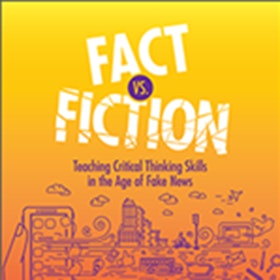New Book from ISTE Shows Educators How to Help Students Distinguish Between Fact and Fiction in the Age of Fake News

WASHINGTON – December 19, 2018 – The International Society for Technology in Education, the premier source for books about education technology, is releasing a new book, Fact Vs. Fiction: Teaching Critical Thinking Skills in the Age of Fake News, to equip educators with tools and resources to help students discern fact from fiction in the information they access not only at school, but on the devices they carry in their pockets and backpacks.
The advent of the 24-hour news cycle, citizen journalism and an increased reliance on social media as a trusted news source have had a profound effect not only on how we get our news, but also on how we evaluate sources of information, share that information and interact with others in online communities. When these issues are coupled with the “fake news” industry that intentionally spreads false stories designed to go viral, educators are left facing a new and challenging landscape. This book will help them address these new realities.
The book includes five core principles to help educators shatter students’ biases while sharpening their information skills:
1. Be aware of your own biases.
2. Think about technology as tools for building empathy.
3. Arm students with language that allows them to challenge ideas, but that does not attack people.
4. Model positive behavior in your own digital and analog interactions.
5. Give students the chance to reflect.
Co-author Darren Hudgens explains that his presentation that informed the book was meant as a wakeup call to educators to discuss issues of digital literacy in schools. “I tried to draw out that this new phenomenon of ‘fake news’ is actually not new, but the growth of the internet and mobile technology it has been scaled like never before. The misinformation filter bubble is alive and well. We aim to empower our readers (and those they educate) to ‘pop it.’”
Co-author Jennifer LaGarde explains that she, too, felt a sense of urgency to be part of the solution: “I want our students to be better than we are at spotting actual bias and disinformation while also being savvy enough to not be manipulated by those who toss around the term ‘fake news’ to describe anything they disagree with.”
“It’s a book that provides educators with strategies to help their kids apply a healthy skepticism to the massive amount of information they consume daily. It’s a book for teachers teaching the ‘notification generation.’”
LaGarde views the book as a call for educators to recognize their own biases, examine the ways those biases affect their teaching, and consider ways to adapt existing media literacy programs so that they relate to the ways today’s learners access information.
The book includes:
- Instructional strategies for combating fake news, including models for evaluating news stories with links to resources on how to include lessons on fake news in your curricula.
- Examples from prominent educators (elementary, secondary and higher ed) who demonstrate how to tackle fake news with students and colleagues.
- A fake news self-assessment with a digital component to help readers evaluate their skills in detecting and managing fake news.
- The book is available for purchase at iste.org/FactVsFiction.
LaGarde works with educators and school and district-level leaders worldwide to develop innovative instructional practices. LaGarde’s work has been recognized by School Library Journal, The New York Times and The Carnegie Corporation. She holds a master’s degree in library science from Appalachian State University and National Board Certification in school library media.
Hudgins is director of instructional technology at the Organization for Educational Technology and Curriculum (OETC). In addition to his professional development responsibilities, Hudgins is the OETC events lead for several boutique events including IntegratED Portland | AcceleratED Portland, SPARK and Leading Schools. Hudgins holds an M.Ed. along with dual bachelor’s degrees in human development and social sciences.
###
About the International Society for Technology in Education
ISTE is a nonprofit organization that works with the global education community to accelerate the use of technology to solve tough problems and inspire innovation. Our worldwide network believes in the potential technology holds to transform teaching and learning.
ISTE sets a bold vision for education transformation through the ISTE Standards, a framework for students, educators, administrators, coaches and computer science educators to rethink education and create innovative learning environments. ISTE hosts the annual ISTE Conference & Expo, one of the world’s most influential edtech events. The organization’s professional learning offerings include online courses, professional networks, year-round academies, peer-reviewed journals and other publications. ISTE is also the leading publisher of books focused on technology in education. For more information or to become an ISTE member, visit iste.org. Subscribe to ISTE’s YouTube channel and connect with ISTE on Twitter, Facebook and LinkedIn.







